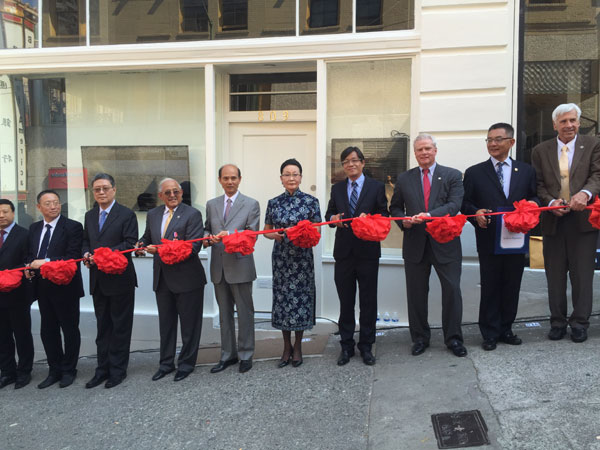'Window' on WWII opens in Bay Area
By LIA ZHU in San Francisco (China Daily USA) Updated: 2015-08-17 14:37
 |
|
Florence Fang (center), curator of the WWII Pacific War Memorial Hall, and guests cut the ribbon at the opening ceremony of the memorial hall in San Francisco on Aug 15, 2015. LIA ZHU / CHINA DAILY |
Christine Qiu was another one of the 14 volunteer guides at the museum. "The war killed 6 million Jews in Europe and more than 100 museums have been set up in the world in memory of them. The number of Chinese people killed by the Japanese army is about six times the Jewish deaths, however, we have just one museum outside China," she said.
"It's necessary for people to learn about the real history so we can cherish the peace we have now," said Qiu, a Silicon Valley engineer.
The museum is not only aimed at telling about the misery and suffering of the Chinese people during the war, but also focused on their fortitude and tenacity in fighting against aggression, and reminding people of the US-China alliance, according to Fang.
The third floor of the museum displays a replica of an Allied military transport aircraft which used to fly "The Hump" over the Himalayas to resupply Chinese war efforts, a parachute used by a Flying tigers' pilot and other exhibits about Americans who traveled to China to fight alongside the Chinese.
The pilot's chute bears witness to the friendship between a US pilot, surnamed Ilnicki, and his Chinese rescuers.
On his way back to Kunming, in Yunnan province, in 1944, Ilnicki's bomber was hit and went down. He parachuted to a village in Hunan province and there he was rescued by local villagers. The pilot chute was then signed by dignitaries and people who helped him after the crash. One of the inscriptions gave an account of the aircraft going down and the pilot parachuting safely to the ground.
"The stories of the Flying Tigers, the Hump and the friendship between the rescued and the rescuers have been passed down from generation to generation," said Luo Linquan, Chinese consul general in San Francisco. "The cross-Pacific alliance between China and the US is an unforgettable part of the world's memory of peace."
Luo said he hoped the museum can serve as a window for overseas Chinese and the American people to learn about this chapter of history, and at the same time demonstrate the Chinese people's achievement in defending national independence, sovereignty and dignity as well as their contribution to the world's anti-fascist war.
liazhu@chinadailyusa.com




